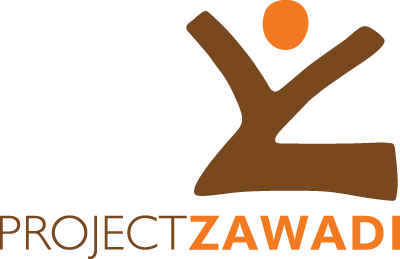Science and Technology in Nyamuswa
Note: Dan McIntyre has been volunteering as a science and technology consultant with Project Zawadi for the past year. Dan’s recent trip to Project Zawadi’s base of operations in rural Nyamuswa was to visit and evaluate the science capabilities and clubs at four of the schools that will be participating in Project Zawadi’s new Model Schools program.
Science and Technology in Nyamuswa
by: Dan McIntyre
Last fall, I traveled to Tanzania and spent two weeks in Nyamuswa evaluating science activities at two primary and two secondary schools that are part of Project Zawadi’s Model Schools program. I brought with me two computers loaded with educational materials to be used by science clubs at the secondary schools (see resource listing at the end of this article), a projector in order to be able to share this content with students in their classrooms, and some materials to be able to conduct science activities.
The Rise of Mobile Betting in Canada: A Closer Look
In recent years, the landscape of sports betting in Canada has undergone a significant transformation with the rise of mobile betting platforms. The convenience and accessibility offered by mobile betting apps have revolutionized the way Canadians engage with their favorite sports and events. As more Canadians turn to their smartphones and tablets to place bets on sports, it has sparked a new wave of interest and conversation around the impact of mobile betting on the industry. In this article, we delve deeper into the phenomenon of mobile betting in Canada, exploring its implications on the traditional betting landscape and the evolving preferences of Canadian bettors.
From the convenience of betting on-the-go to the wide array of betting options available at their fingertips, mobile betting has become a game-changer for Canadian sports enthusiasts. But with this convenience comes questions about responsible gambling, regulatory challenges, and the overall impact on the sports betting industry. Join us as we take a closer look at the rapid growth of mobile betting in Canada, unpacking the key drivers behind its popularity and examining the potential challenges and opportunities it presents. As the mobile betting trend continues to gain momentum, what does the future hold for the Canadian sports betting landscape? Let’s explore together.
The Evolution of Mobile Betting Platforms in Canada
Mobile betting in Canada has experienced a significant surge in popularity in recent years, with more and more Canadians turning to their smartphones and tablets to place bets on their favorite sports events. The convenience and accessibility of mobile betting platforms have played a key role in this rise, allowing users to wager on-the-go without being tied to a physical location.
One of the platforms that have contributed to the growth of mobile betting in Canada is BetLama. With its user-friendly interface and a wide range of betting options, BetLama has quickly gained a strong following among Canadian bettors. The platform offers a seamless mobile betting experience, allowing users to place bets easily and securely from their mobile devices.
https://betlama.com/ offers a diverse selection of sports events and betting markets, catering to the preferences of a wide range of Canadian bettors. From popular sports like hockey and basketball to niche events, BetLama provides a comprehensive betting experience for users looking to wager on their favorite sports.
As mobile betting continues to gain traction in Canada, platforms like BetLama are expected to play a significant role in shaping the future of the industry. With advancements in technology and an increasing demand for mobile-friendly betting options, the rise of mobile betting in Canada is set to continue on its upward trajectory.
Regulatory Challenges and Opportunities for Mobile Betting
Mobile betting in Canada has seen a significant rise in popularity in recent years, with more and more Canadians turning to their smartphones and tablets to place bets on their favorite sports events and casino games. The convenience and accessibility offered by mobile betting apps have revolutionized the gambling industry in Canada, allowing users to wager on-the-go without being tied to a physical location. This shift towards mobile betting has been further accelerated by advancements in technology, making it easier and more secure for Canadians to participate in online betting activities.
Furthermore, the rise of mobile betting in Canada has also been fueled by the increasing number of online betting platforms that cater specifically to the Canadian market. These platforms offer a wide range of betting options, competitive odds, and attractive bonuses to entice Canadian bettors. With the convenience of being able to place bets anytime and anywhere, coupled with the excitement of live betting and instant payouts, it’s no surprise that mobile betting has become a preferred choice for many Canadians looking to engage in online gambling activities.
Impact of Mobile Betting on Traditional Gambling Practices
Mobile betting in Canada has witnessed a significant surge in popularity in recent years, driven by the widespread adoption of smartphones and the convenience they offer to users. With smartphones becoming an integral part of daily life, Canadians are increasingly turning to mobile betting platforms to place their bets on various sports events and casino games. This trend has been further accelerated by the advancement of technology, making it easier for users to access betting apps and websites on the go.
One of the key factors contributing to the rise of mobile betting in Canada is the convenience and flexibility it provides to users. With just a few taps on their smartphones, Canadians can place bets anytime, anywhere, without the need to visit a physical betting location. This accessibility has made betting more convenient and appealing to a wider audience, including younger demographics who are more accustomed to using mobile devices for various activities.
Moreover, the competitive nature of the mobile betting industry in Canada has led to the development of user-friendly interfaces, innovative features, and attractive bonuses to attract and retain customers. Betting operators are constantly striving to improve the overall user experience, offering a wide range of betting options and real-time updates on sports events to keep users engaged. This fierce competition has contributed to the growth of the mobile betting market in Canada.
As mobile betting continues to gain momentum in Canada, regulators are also closely monitoring the industry to ensure responsible gambling practices are upheld. With the increasing popularity of mobile betting, measures are being put in place to protect vulnerable individuals and promote safe betting environments. The rise of mobile betting in Canada reflects a larger global trend towards digitalization in the gambling industry, reshaping the way people engage with betting activities.
Future Trends and Implications for the Canadian Betting Industry
Mobile betting in Canada has experienced a significant surge in popularity in recent years, driven by the widespread adoption of smartphones and the convenience they offer. With the advancement of technology and the increasing availability of high-speed internet, Canadians are increasingly turning to mobile devices to place bets on their favorite sports events and casino games. The ease of access to online betting platforms through mobile apps has revolutionized the gambling industry in Canada, making it more accessible and convenient for users to engage in betting activities from anywhere at any time.
Furthermore, the rise of mobile betting in Canada has not only provided users with convenience but has also opened up a new avenue for operators to reach a larger audience. Mobile betting apps offer a user-friendly interface, secure payment options, and a wide range of betting markets, attracting both seasoned bettors and newcomers alike. As more Canadians embrace mobile betting, the industry is expected to continue its growth trajectory, shaping the future of gambling in Canada and revolutionizing the way people engage with sports betting and online casinos.
As mobile betting continues to gain momentum in Canada, it is clear that the landscape of sports gambling is rapidly evolving. With the convenience and accessibility of betting platforms on smartphones, Canadians are embracing this new way to engage with their favorite sports and teams. The rise of mobile betting not only offers a seamless betting experience but also opens up a world of opportunities for sports enthusiasts across the country. As technology advances and regulations adapt, the future of mobile betting in Canada looks promising, promising a thrilling and dynamic betting experience for all.
Shika na Mikono is a set of manuals that were prepared by Tanzanian teachers and US Peace Corps Volunteers. Translating as “Hands on Activities”, these manuals serve as a guide for teachers to conduct science activities in village schools using available resources. Copies of the Shika na Mikono manuals for the subjects of Biology, Chemistry, Physics, and Mathematics were printed in the nearby town of Bunda so that each secondary school would have a copy. The manuals follow the Tanzanian syllabus, so it is easy for teachers to find an activity for each week’s learning topic. The manuals are great guides for teachers who might not otherwise have much experience with doing science activities.
Nyamang’uta Secondary School
I spent several days at Nyamang’uta Secondary School, which is the secondary school where Project Zawadi Director Adrian Maganga was headmaster. It is a newer school and still building infrastructure. They do not have a science laboratory yet. It will soon be wired for electricity, but when I visited only the teachers’ housing had power. Extension cords allowed us to use the computer and projectors to show Swahili videos on sexual health to the students. The science teachers at Nyamang’uta then organized the students to do some hands on chemistry experiments, including making a sand water filter and creating hydrogen gas.
The next day I returned to the school and discussed with students how computers work. Students had a chance to use the computers to explore the educational content. I was surprised at how interested they were in the English-language science videos, which they said they understood with the help of the visual context.
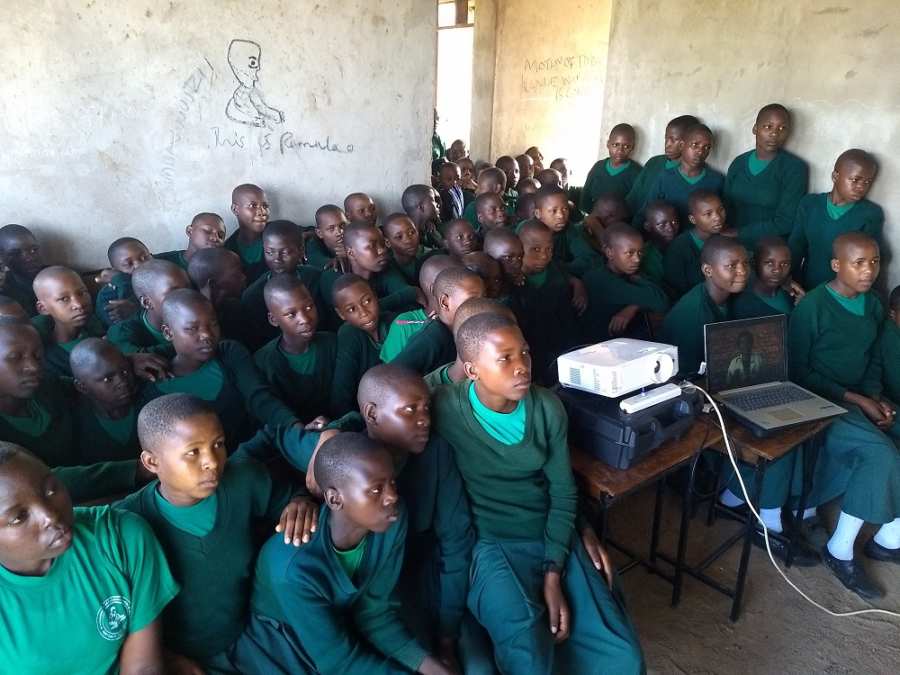
Girls watching a video in Swahili on reproductive health.
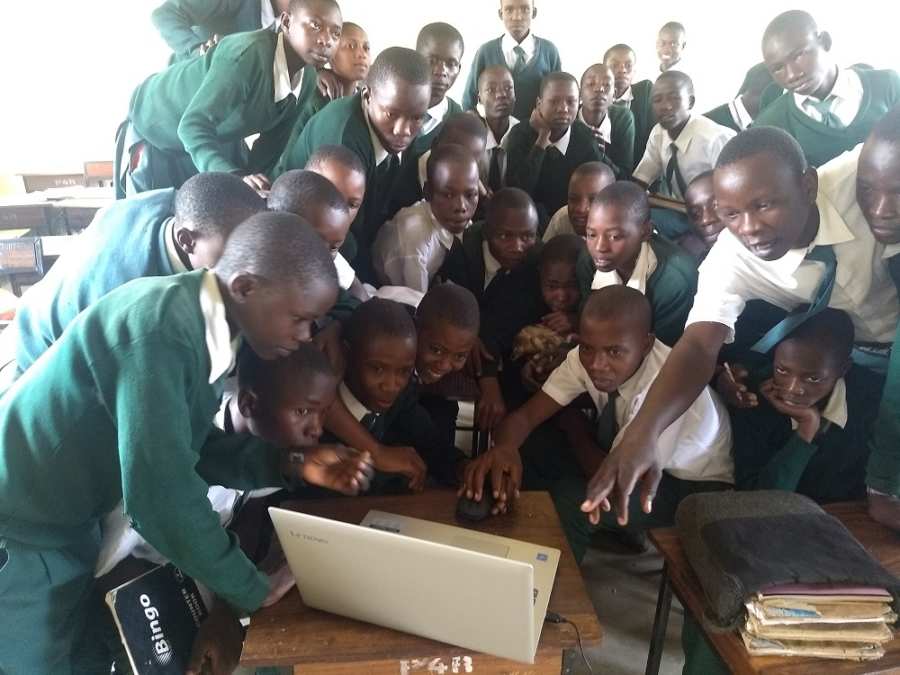
Students watching science videos on computer.
Makongoro Secondary School
I then visited nearby Makongoro Secondary School. Older and larger than Nyamang’uta, Makongoro has nice science laboratories with benches, gas burners, and sinks. Makongoro has a functioning science club and I met with those students. One student prepared soap from sunflower oil using a procedure from the manual and the students were actively exploring the science content on the computer. Since I’ve been back, I have heard from the science teachers that the students are meeting every Friday to explore the content on the computer and to conduct science activities.
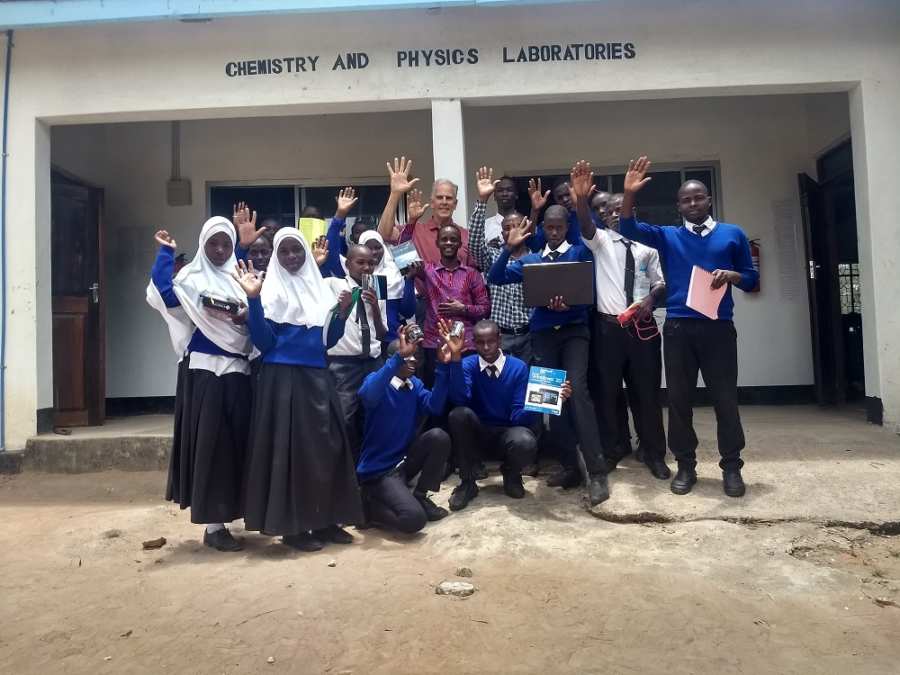
Makongoro’s science club.
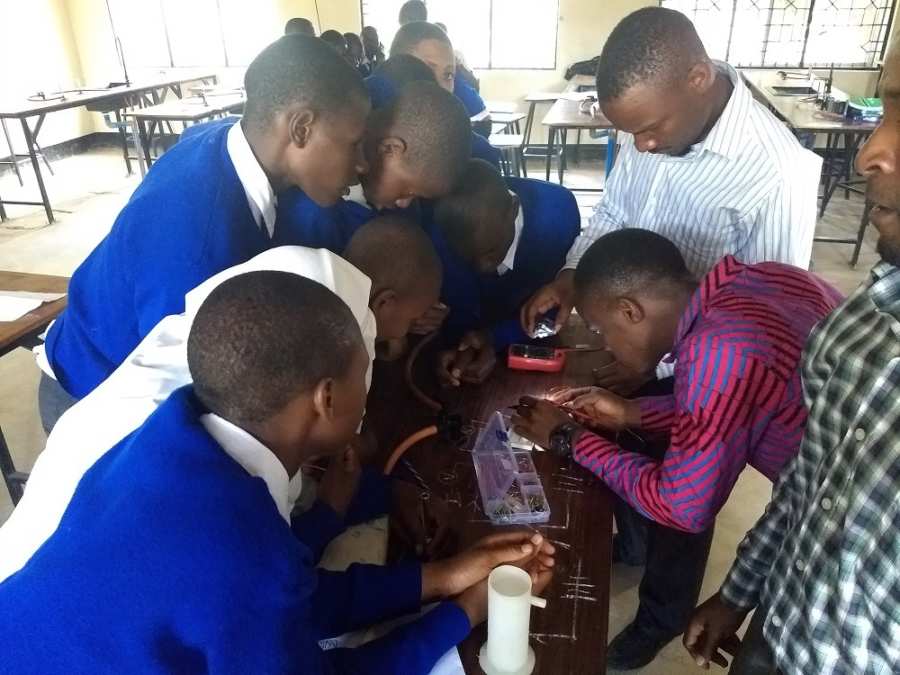
Students creating an electrical circuit and testing it with a multimeter.
Busore Primary School
Busore has an existing kit of materials for science activities which is being stored in the head teacher’s office. It doesn’t appear to be regularly used. After a tour of the school, a teacher and I did some simple science activities with her classes using balloons and handheld microscopes. This teacher spoke excellent English and is now helping with Project Zawadi’s English Bridge Program.
After the activities, we were able to set up the projector in a classroom and showed health videos in Swahili on topics of sexual health, safe water, and cholera to the older students. The younger students watched a cholera animation and some videos in English from Planet Earth, which were explained by Project Zawadi staff in Swahili for the students.
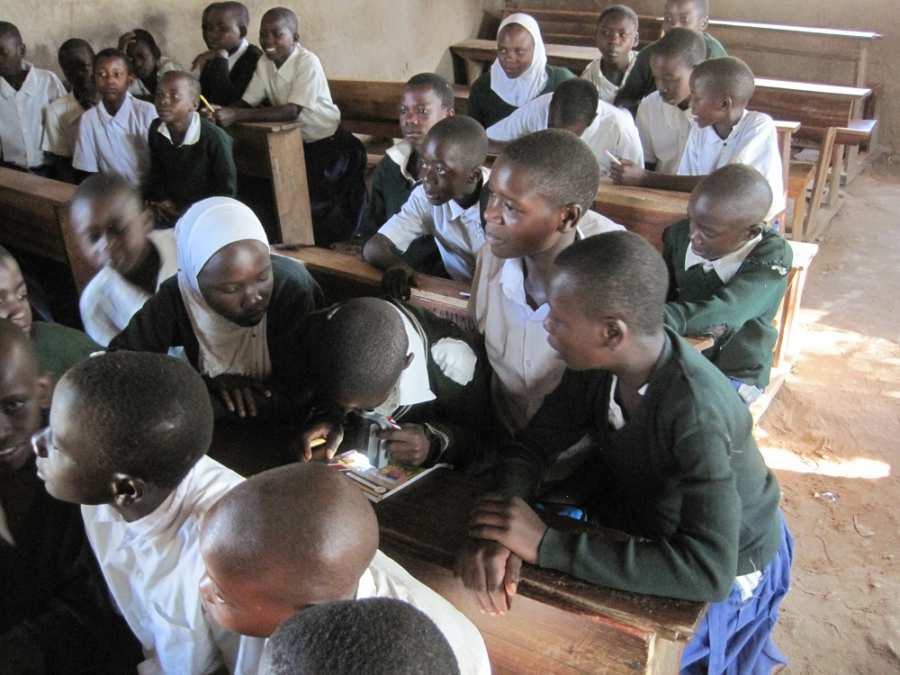
Students seeing dots of the three primary colors in printed pictures.
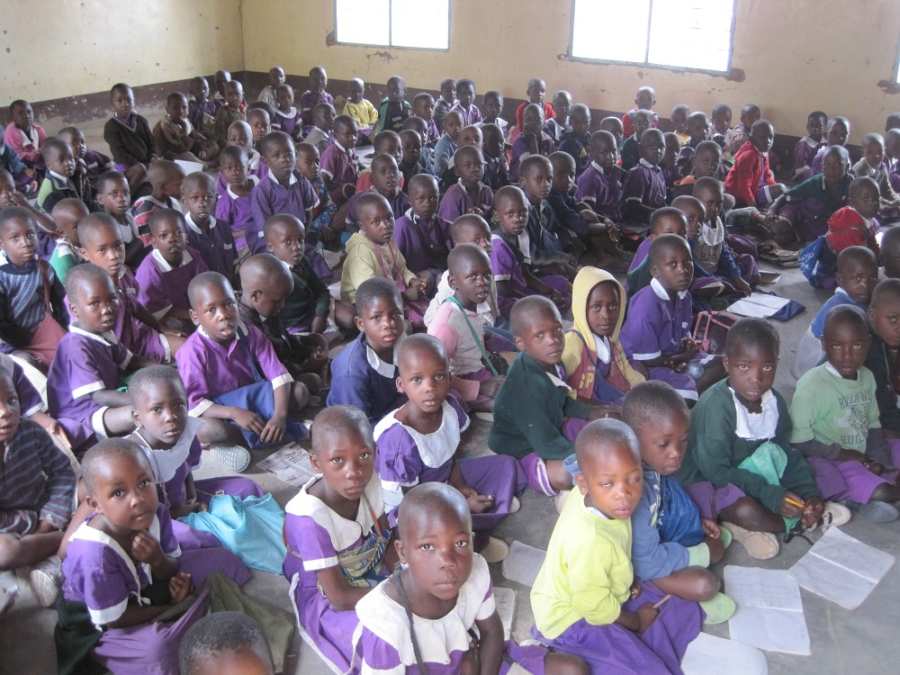
Attentive Kindergarten students at Busore.
Sarawe Primary School
The Ward Education Officer asked us to conduct a training session for teachers from several local schools on science activities for primary school. Science students and teachers from Makongoro and Nyamang’uta Secondary schools presented some demonstrations to 10 primary teachers and a group of selected students from Sarawe Primary. The teachers were very interested in the activities and decided to form a group to share science activity tips and ideas using “What’s App” on their mobile phones to communicate.
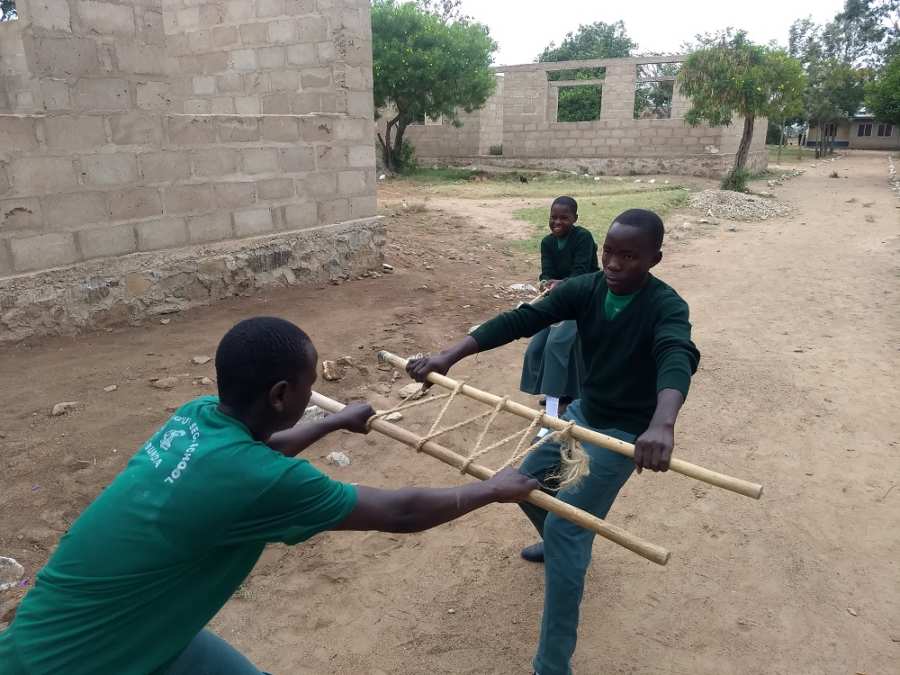
Shika na Mikono manual activity using locally available materials to demonstrate the concept of mechanical advantage.
The Importance of the English Bridge
In Tanzania, the language of instruction switches from Swahili to English when a student enters secondary school. Like most secondary schools in Tanzania, local schools have “Speak English” signs posted around the school grounds. However, I never heard English spoken at the schools other than when a formal lecture was given or someone was addressing me. It is understandable that students prefer to use Swahili, but English skills are extremely important in secondary school for understanding classroom instruction. It’s also the language used on the National Exams, which determine whether a student is eligible to continue their schooling or not. Much of a student’s poor exam performance can be attributed to poor skills in the English language and is not necessarily representative of their actual learning and knowledge. It is for this reason that Project Zawadi’s English Bridge program is so important.
The English Bridge program is a seven-week English intensive workshop. The workshop is offered to Project Zawadi sponsored students and other selected students during the winter break period before they enter secondary school. Designed to give students a leg up in their conversational English skills (speaking, listening, and comprehension), it helps position students for more success as they navigate the transition to secondary school and the new language of instruction.
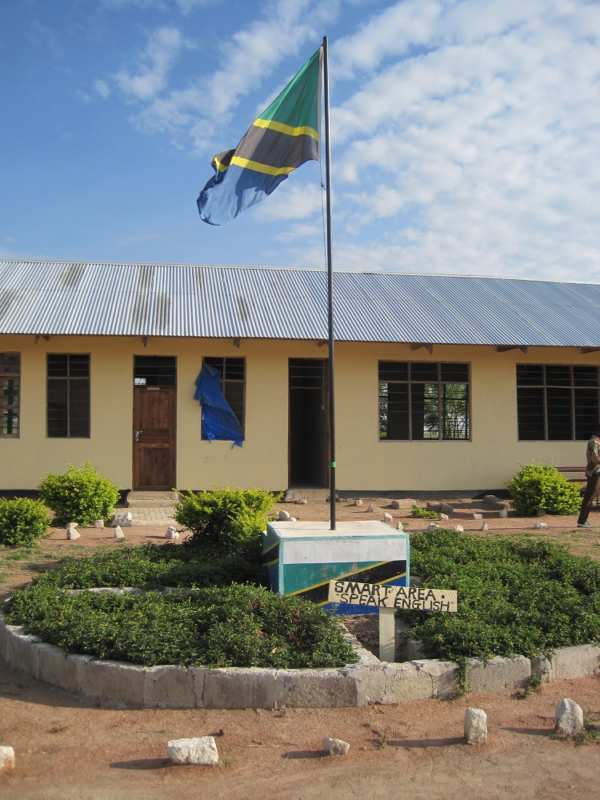
“Smart Area, Speak English” sign at Nyamang’uta Secondary school.
In Conclusion
Students are very enthusiastic learners and work very hard. The projector was a useful tool for making use of a single computer with many students. The English videos have potential to improve English as well as in teaching science content, especially when using DVDs and enabling English subtitles for students to read along.
All the schools were receptive to increasing science activities as part of their science classes. Science is also a priority area for improvement by the Tanzania government. The future is bright for student with a science background. There are many employment opportunities in fields such as nursing and other medical fields, teaching, and engineering.
More Information
Below are links to the educational materials that were loaded onto the computers:
- RACHEL Educational content including a Wikipedia selection, Khan Academy Math and Science Videos, Textbooks and Literature, Medical Encyclopedia, and more. http://rachelfriends.org/previews/rachelpi_64EN_4.0/
- PhET Science Simulations are interactive applets that demonstrate science principles by allowing students to vary parameters and see the effects. https://phet.colorado.edu/
- Past Form IV National Exams, you will be impressed at how difficult they are. https://maktaba.tetea.org/past-exams/csee/
- Shika na Mikono Manuals for science activities. They also show the Tanzanian Science Curriculum. You can download copies of these manuals here: https://maktaba.tetea.org/study-resources/o-level-resources/
Final Thanks
During my time in Nyamuswa, I was fortunate to be able to stay with Project Zawadi Director, Adrian Maganga, and his family at their home. I was welcomed and made to feel at home and it was really nice to be based so close to the schools. I also had the opportunity to take a fun excursion with them to the museum in nearby Butiama, the birthplace of Tanzania’s first President, Mwalimu Julius Nyerere. Asante sana, Adrian and family!
